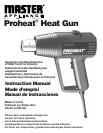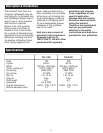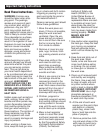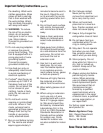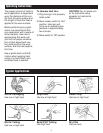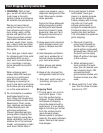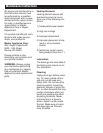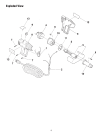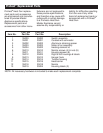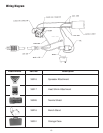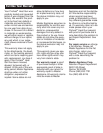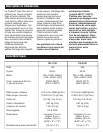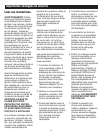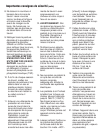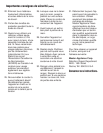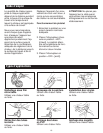
vapors are present, use a
respirator designed to filter
lead. Move work outside
when possible.
Failure to follow adequate
safety precautions when
working with lead based
paint could result in lead
poisoning. See our Paint
Stripping instructions for
more information.
3) Keep away from chemical
paint strippers which can
ignite or release harmful
vapors.
4) Use adequate ventilation
(such as a window fan in
exhaust mode) and keep
your work area clean.
5) Wear gloves and safety
glasses at all times.
6) Keep a fully charged fire
extinguisher close at hand.
7) Stay alert, watch what you
are doing, and use com-
mon sense.
Stripping Paint
1) To strip paint, turn unit on
and hold it about 1 inch
from the surface being
stripped. Proper distance
and speed of stripping
should be determined by
experience. It is an advan-
tage to hold the gun further
from the surface and to
move forward slowly.
Slower speed is compen-
sated by the wider softened
areas. Heat will also pene-
trate deeper.
1) WARNING: With a heat
gun, as with all other heat
tools, keep a fire extin-
guisher handy and observe
all sensible fire precautions.
We do not recommend
using this heat gun on hol-
low surfaces such as out-
door siding, walls, soffits,
panels and partitions, etc.
These areas often contain
flammable materials such
as dust, wood chips, insula-
tion, rodent nests and other
debris which could acciden-
tally ignite.
Your heat gun is best used
for stripping paint from solid
woodwork with ins and
outs, such as solid interior
trim, mouldings, turnings,
doors balusters and porch
trim, etc.
When stripping paint,
always keep the heat gun
moving in a continuous
back and forth motion.
Stopping or pausing too
long in one spot could ignite
the surface you are working
on or the area behind it.
2) Do not breathe or swallow
lead based paint in any
form. Many old homes and
other buildings contain lead
based paint. Dust, scrap-
ings, residues and vapors
of lead based paint are
extremely poisonous.
Prevent possible lead poi-
soning when stripping this
type of paint by using ade-
quate ventilation (such as a
window fan in the exhaust
mode), and keeping a clean
work area. When dust or
2) As paint begins to blister
and bubble, move gun
slowly in a steady progres-
sion across the surface.
Follow closely with a scrap-
ing knife (a 2-inch-wall
scraper works best) to
scrape the loosened paint.
Preheat scraper as you are
heating the paint surface.
This increases the speed of
paint stripping.
a. Removal of paint by
using heat is based on
the fact that all organic
paints soften at elevated
temperatures. When soft,
the paint can be easily
lifted off without damage
to the surface.
b. When stripping paint
from grooves in mould-
ings, you can devise your
own scraping tools. Old
screwdrivers with
ground-down blades and
linoleum knives are often
used.
3) Move switch to "Low" after
use. Run for three minutes
and turn to “Off” .
6
Paint Stripping Safety Instructions



